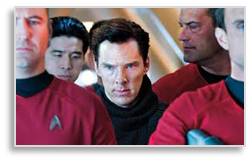Going to see the new Star Trek movie on opening weekend was a no-brainer. We’ve both been Trek fans for many years and we looked forward to this new installment of the J.J. Abrams re-boot series. Yet we walked out of Star Trek: Into Darkness both dismayed and disappointed. I wish I could recommend this movie but that’s just not the case.
What went wrong? For me, it was a lot.
Difference in Outlook
First there’s the disconnect between Gene Roddenberry’s vision and Abrams’s outlook. The topic is terrorism, so it’s inevitable that there will be darkness of several types. In the original series, Roddenberry attacked many thorny issues, from racism to militarism, that were otherwise ignored on TV. He took to heart Rod Serling’s comment that, “I can put words in the mouths of aliens that can never be spoken by Democrats and Republicans.” Mr. Roddenberry would certainly have done a program on the subject of terrorism, but at heart he was an optimist who believed in a bright future for humanity.
Mr. Roddenberry’s Enterprise crew frequently had to go through darkness before they solved the problem, fixed the issue, discovered the antidote, found a road to peace, resolved a conflict, or otherwise got to the far side with a better way. They were on a journey of discovery and were ruled by the Prime Directive not to interfere with the internal development of alien races or species. They were not particularly good at following General Order Number 1, however, because they wanted to save lives and make things better for the aliens they encountered.
Star Trek: Into Darkness honors this tradition by violating the Prime Directive right out of the box with the crew arguing about it as they do so. After that, however, it devolves into a slam-bang action movie of the worst kind. This is what Star Trek would have looked like if Michael Bay had taken over the franchise.
In summary, here is the entire plot: explosions, destruction, death, more explosions, more destruction, different kinds of death, bad science, fist fights, phaser fights, gun fights, more explosions, different bad science, a lot more death, threats, betrayal, more explosions, a feel-good scene . . . The End.
Critics Kinder Than I
This is my opinion and a lot of people clearly disagree with me. Paramount Pictures estimates that it grossed $70.6 million in the U.S. and Canada alone and international grosses are 82% higher than for Mr. Abrams’s first Star Trek movie in the same time period. It took in $80.5 million foreign ticket sales. That’s all good.
The critics were also kinder than I thought the movie warranted. In The Washington Post, Ann Hornaday says that Abrams, “still has the golden touch.” John Anderson in The Wall Street Journal comes closer when he calls it, “noisy, frenetic, grandiose and essentially a soap opera.” Its IMDB rating is 8.3 and Rotten Tomatoes gives it an 87% Fresh rating on the Tomatometer.
So what’s my problem? I wanted substance, good dialogue, consistency with established rules, and thoughtful problem solving. Above all, I wanted logic—in the plot, in the science, in the very core of the movie. Instead I was constantly thrown out of the movie by action at the expense of writing, special effects at the expense of character development, and expedience at the expense of science.
To be specific: (Spoiler Alert: If you are planning to see Star Trek: Into Darkness, skip right to the end.)
- To save the life of his daughter, a Federation officer is willing to sacrifice the lives of many others—as well as his own. He does this without any hint of conflict, remorse, or professional ethics.
- To open a dangerous photon torpedo, two members of the crew take it to the surface of a barren and rocky “planetoid” where they work without space suits to protect them from vacuum, cold, or solar radiation.
- The first movie established that it’s dangerous to go to warp speed inside the solar system but, hey, “Punch it.”
- Star Trek Next Generation established that you can’t beam someone out of a ship if its shields are up. And yet this happens.
- A pumped-up Benedict Cumberbatch makes a satisfying villain but not this particular villain. Ricardo Montalban made Khan Noonien Singh his own and forever burned into our minds that character’s look and accent. Mr. Cumberbatch, with his Oxford looks and speech, just doesn’t match that image.
- The Enterprise can stop a volcano from erupting with a cold-fusion device but it has to be triggered manually from inside the core. One would think that this level of technology would make a remote trigger possible. And Spock’s spacesuit prevents him from combusting spontaneously while he stands on nearly molten rock. He doesn’t even break a sweat.
- The Enterprise is built for deep space but, somehow, it can go underwater without being damaged. I could believe that shields would keep water away from the hull but that’s not what we see when good old NCC-1701 emerges from Nibiru’s ocean, water streaming off the hull and out of the engine nacelles.
- Why does Scotty try to argue with a hostile and much larger security guard instead of just stunning him? He’s got the phaser.
These are just a few of the things that kept me from being engrossed by Star Trek: Into Darkness and that made us deeply disappointed as we left. If I want to see a Michael Bay movie (and I usually don’t), I’ll go to see one knowing what to expect. I expected more from J.J. Abrams.




